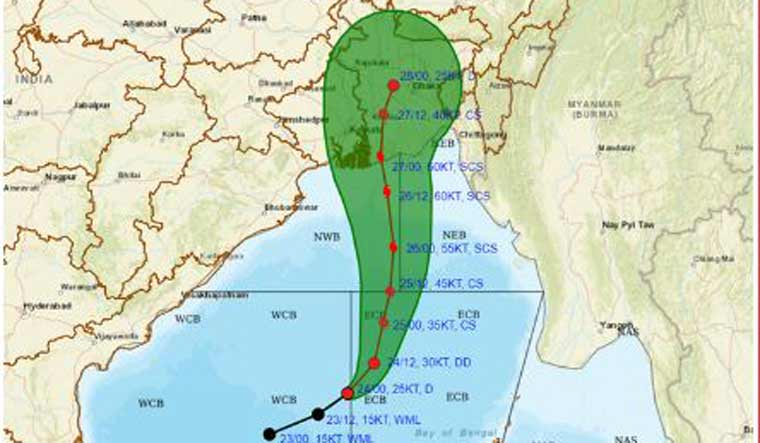The Indian Meteorological Department (IMD) has said that the well-marked low-pressure system over the central Bay of Bengal has intensified into a depression on Friday morning.
This phenomenon will move northeastwards and intensify further into a cyclone over east-central Bay of Bengal by Saturday morning. It would subsequently move northwards as it intensifies into a severe cyclone by that evening.
"Continuing to move nearly northward, it is very likely to cross the Bangladesh and adjoining West Bengal coasts between Sagar Island and Khepupara around midnight on May 26 as a severe cyclonic storm," the IMD alert read.
The IMD has also warned that the cyclone could reach a wind speed of 102 kilometres per hour on Sunday.
While the first cyclone in the Bay of Bengal this pre-monsoon season will cause heavy rainfall in the coastal districts of West Bengal, north Odisha, Mizoram, Tripura and south Manipur this weekend, the most affected will be Kolkata, Howrah, Nadia, Jhargram, North 24 Parganas, South 24 Parganas and Purba Medinipur districts where an orange alert for light to moderate rainfall is in place.
Fisherfolk out at sea have been advised to return to the coast and not venture into the Bay of Bengal until next Monday.
At present, most of Bengal is experiencing dry weather with temperatures hovering around 34.8 degree Celsius. The dry weather is expected in Alipurduar, Cooch Behar, North Dinajpur, South Dinajpur, and Malda.
Why cyclonic storms?
Warmer sea surface temperatures caused by oceans absorbing most of the excess heat from greenhouse gas emissions have contributed to cyclonic storms intensifying rapidly and retaining potency. The past 30 years have witnessed the highest sea surface temperatures since records began in 1880.
Senior IMD scientist DS Pai told PTI that warmer sea surface temperatures mean more moisture, which is favourable for the intensification of cyclones.
While a sea surface temperature of 27 degrees Celsius and above is needed for a low-pressure system to intensify into a cyclone, the current sea surface temperature in the Bay of Bengal is around 30 degrees Celsius at present.
However, the cyclone will not affect the monsoon progress which is set to hit Kerala on May 31, except in some parts. "Initially, the system will help the monsoon progress over the Bay of Bengal. Thereafter, it will detach from the monsoon circulation and pull a lot of moisture, which could result in a slight delay in the monsoon progress in that area," Pai added.








